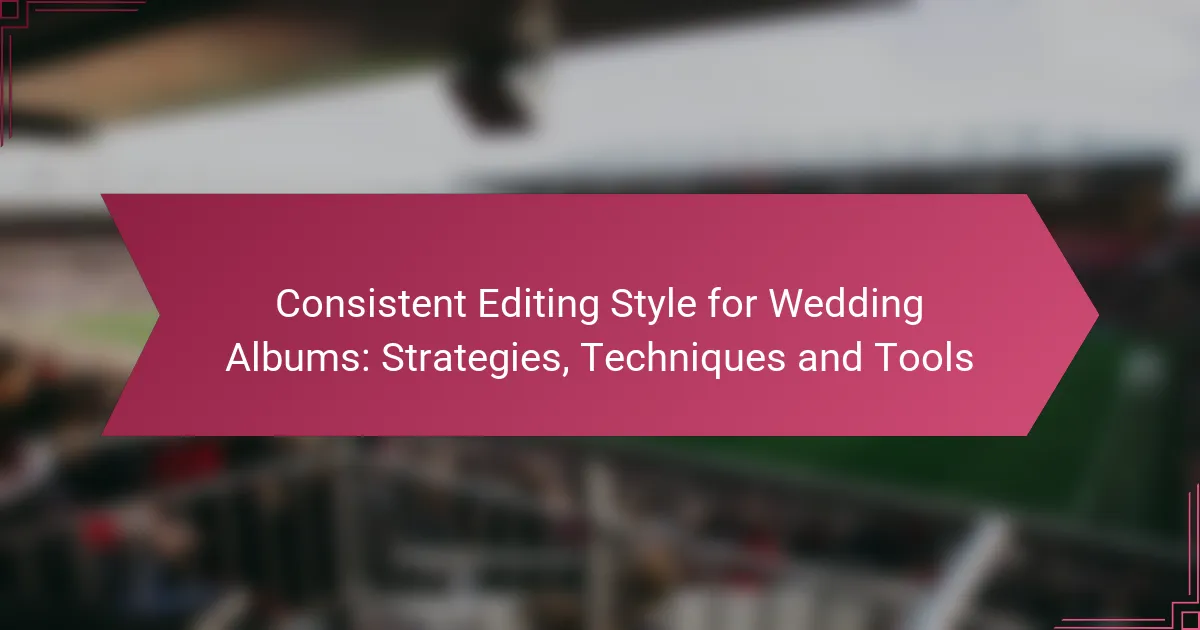Creating a consistent editing style for wedding albums is essential for presenting a cohesive visual narrative that aligns with the couple’s vision. By establishing a unified color palette, employing uniform filters, and utilizing batch editing techniques, photographers can ensure that each image complements the others. Leveraging tools like Adobe Lightroom and Capture One Pro further streamlines the editing process, allowing for a polished and harmonious final product.

What Are Effective Strategies for Consistent Editing Style in Wedding Albums?
Effective strategies for maintaining a consistent editing style in wedding albums include establishing a cohesive color palette, using uniform filters, and adhering to specific layouts. These practices ensure that the final product reflects a unified aesthetic that resonates with the couple’s vision.
Establishing a Color Palette
Choosing a color palette is essential for creating a harmonious look throughout the wedding album. Start by selecting a few key colors that reflect the wedding theme and the couple’s preferences. Aim for a palette of three to five colors to maintain simplicity while allowing for variety.
When editing, consistently apply these colors to images through adjustments in saturation, contrast, and brightness. This not only enhances the visual appeal but also ties together different sections of the album, making it feel cohesive.
Using Consistent Filters
Applying the same filters across all images helps maintain a uniform style in wedding albums. Select a filter that complements the chosen color palette and enhances the overall mood of the photos. For example, a warm filter can evoke a romantic atmosphere, while a cooler one might convey elegance.
Be mindful of the intensity of the filter; subtlety often works best to avoid overwhelming the images. Test the filter on a few photos before applying it to the entire album to ensure it aligns with the desired aesthetic.
Maintaining Uniform Layouts
Consistent layouts are crucial for a polished wedding album. Decide on a layout style—such as grid, full-page spreads, or a mix—and stick to it throughout the album. This creates a predictable flow that guides viewers through the story of the day.
Consider using templates to streamline the layout process. Templates can save time and ensure that each page adheres to the established design, allowing for a more efficient editing workflow.
Creating a Style Guide
A style guide serves as a reference for maintaining consistency in editing. Outline key elements such as color palettes, filter choices, and layout styles. This guide can be particularly useful when collaborating with other editors or when working on multiple albums.
Include examples of preferred edits and layouts within the guide. This visual reference helps ensure that everyone involved in the editing process is aligned with the overall vision for the wedding album.
Incorporating Client Preferences
Understanding and incorporating client preferences is vital for a successful wedding album. Engage with the couple early in the process to discuss their desired style, themes, and any specific requests they may have. This ensures that the final product reflects their unique story.
Be flexible in your editing approach while still adhering to the established strategies. Balancing personal style with client preferences can enhance satisfaction and result in a more personalized album that resonates with the couple.
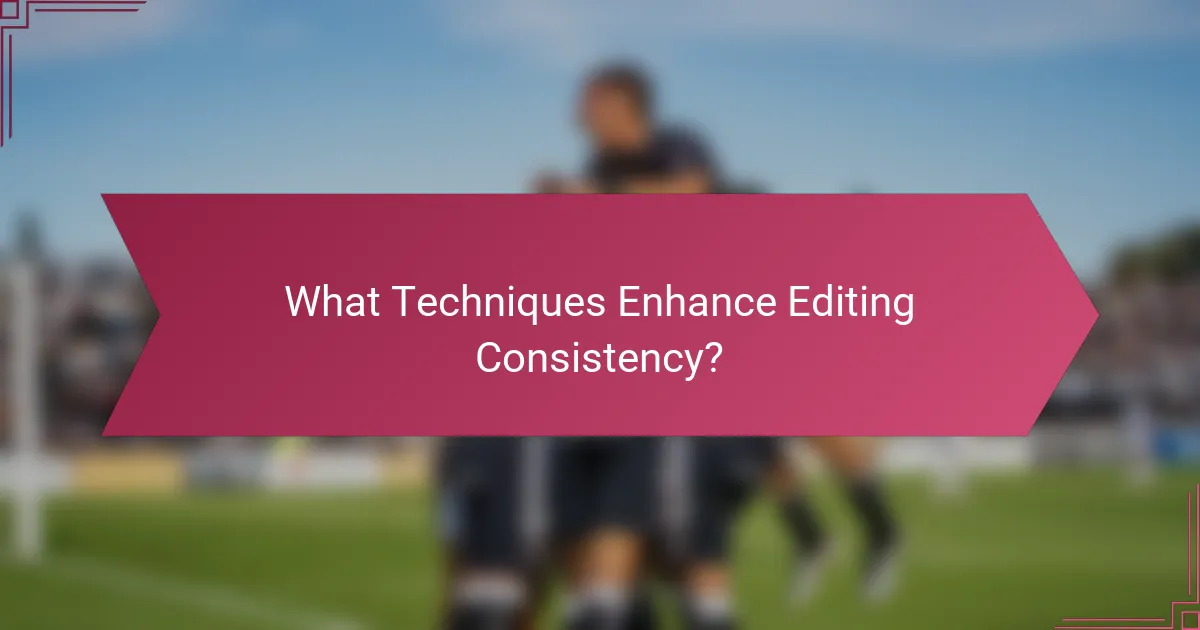
What Techniques Enhance Editing Consistency?
Techniques that enhance editing consistency include batch editing, utilizing presets, and applying uniform cropping methods. These strategies help maintain a cohesive look across wedding albums, ensuring that images complement each other and convey a unified story.
Batch Editing for Cohesion
Batch editing allows you to apply the same adjustments to multiple images simultaneously, promoting visual harmony. This technique is particularly useful for wedding albums where similar lighting and settings are present across various shots.
To effectively batch edit, select a group of photos that share similar characteristics, then apply your desired edits—such as exposure, contrast, and color balance—to all selected images. This saves time and ensures that the overall aesthetic remains consistent.
Utilizing Presets in Lightroom
Presets in Lightroom are pre-defined settings that can be applied to images for quick and consistent edits. By creating or using existing presets tailored to your style, you can ensure that all photos in a wedding album maintain a similar look and feel.
When using presets, consider adjusting them slightly for individual images to account for variations in lighting or color. This approach balances efficiency with the need for personalized touches, resulting in a polished final product.
Applying Consistent Cropping Techniques
Consistent cropping techniques help maintain a uniform composition across your wedding album. Decide on a standard aspect ratio—such as 4:5 or 16:9—and apply it to all images to create a cohesive visual flow.
When cropping, focus on key elements within the frame and ensure that similar subjects are treated consistently. Avoid excessive cropping that may distort important details or alter the intended message of the photograph. A checklist for cropping could include: maintaining the same aspect ratio, centering key subjects, and ensuring balance in composition.
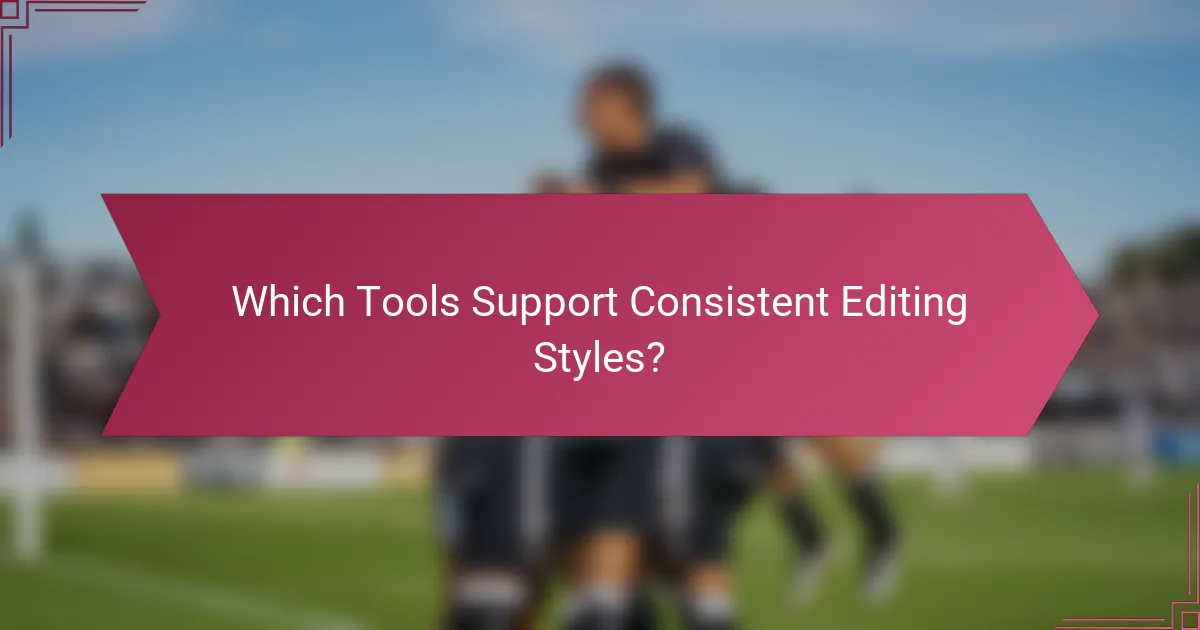
Which Tools Support Consistent Editing Styles?
Several tools can help achieve consistent editing styles for wedding albums, ensuring a uniform look across all images. Utilizing software like Adobe Lightroom, Capture One Pro, and Photoshop Actions can streamline the editing process and enhance the overall aesthetic of your albums.
Adobe Lightroom
Adobe Lightroom is a powerful tool for photographers looking to maintain a consistent editing style. Its robust cataloging features allow you to apply presets across multiple images, ensuring uniformity in color grading and exposure. You can create custom presets tailored to your specific style, which can be easily applied to new photos as you edit.
When using Lightroom, consider organizing your presets into collections based on themes or styles. This will help you quickly access the right look for different wedding albums, whether you’re aiming for a vintage feel or a modern aesthetic.
Capture One Pro
Capture One Pro is another excellent option for achieving consistent editing styles, particularly favored by professional photographers. It offers advanced color grading tools and customizable workspaces, allowing for a tailored editing experience. You can create styles that can be applied to batches of images, ensuring a cohesive look throughout your album.
One of the key advantages of Capture One is its tethering capabilities, which allow you to see edits in real-time as you shoot. This can help maintain consistency from the moment you capture the images to the final edits.
Photoshop Actions
Photoshop Actions enable photographers to automate repetitive tasks, which is essential for maintaining a consistent editing style. By recording a series of edits as an action, you can apply the same adjustments to multiple images with just one click. This saves time and ensures that every photo adheres to your desired style.
To maximize the effectiveness of Photoshop Actions, consider creating a library of actions for different styles or effects. This way, you can quickly switch between looks depending on the theme of the wedding album you are working on.
Canva for Album Design
Canva is a user-friendly design tool that can help you create visually appealing wedding albums with a consistent style. While it is primarily a graphic design platform, its templates and drag-and-drop interface make it easy to maintain uniformity in layout and design elements across your album pages.
When using Canva, take advantage of its brand kit feature to store your color palettes, fonts, and logos. This ensures that every design element aligns with your overall branding, creating a cohesive look throughout the wedding album.

How to Choose the Right Editing Style for Wedding Albums?
Choosing the right editing style for wedding albums involves understanding the couple’s preferences, the photography style, and the overall theme of the album. A cohesive editing style enhances the storytelling aspect of the album and ensures a visually appealing presentation.
Assessing Client Vision
Begin by discussing the couple’s vision for their wedding album. Ask them about their favorite colors, moods, and specific styles they admire, such as vintage, modern, or documentary. This conversation will help you align your editing approach with their expectations.
Consider creating a mood board that incorporates their ideas and examples of different editing styles. This visual aid can facilitate clearer communication and ensure that both you and the couple are on the same page.
Evaluating Photography Style
Next, evaluate the photography style used during the wedding. If the photographer employed a bright and airy approach, a light and vibrant editing style would complement it well. Conversely, if the images are more dramatic or moody, consider a richer, more saturated editing style.
Reviewing a selection of the raw images can provide insight into the best editing techniques to use. Look for consistent elements such as lighting, color tones, and composition that can guide your editing choices.
Considering Album Theme
The overall theme of the wedding album should also influence your editing style. For example, a rustic-themed wedding may benefit from warm, earthy tones, while a beach wedding could be enhanced with soft blues and whites. Aligning the editing style with the theme creates a harmonious look throughout the album.
Additionally, think about the flow of the album. A consistent editing style across different sections will help maintain a cohesive narrative. Use similar filters or adjustments to ensure that transitions between various parts of the album feel seamless and intentional.
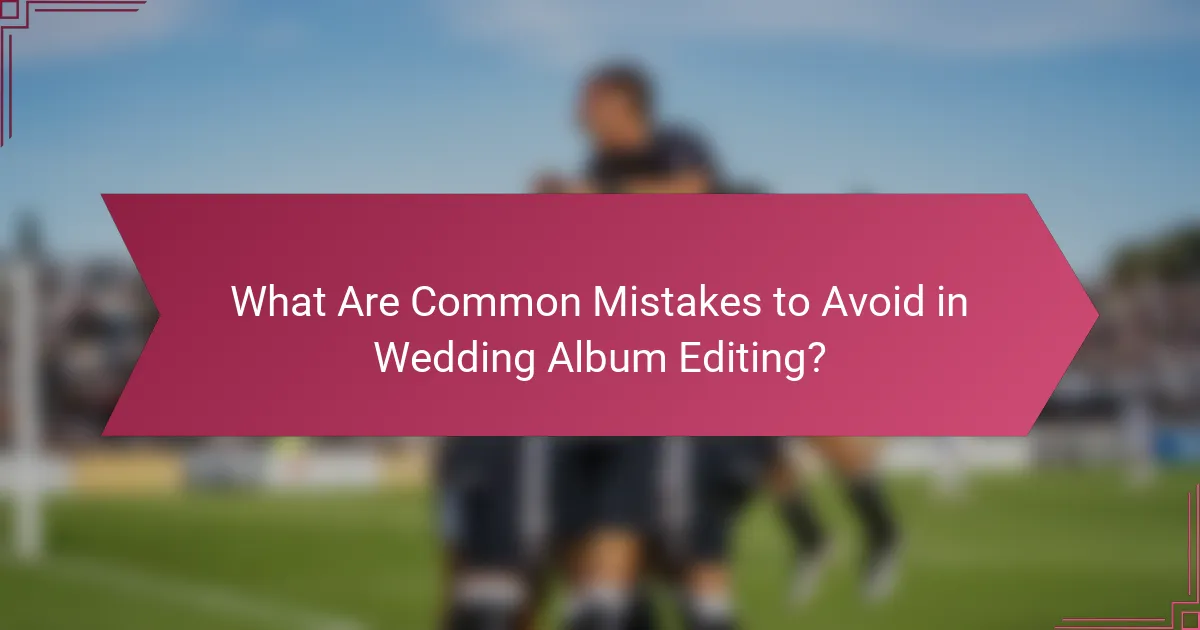
What Are Common Mistakes to Avoid in Wedding Album Editing?
Avoiding common mistakes in wedding album editing is crucial for creating a polished final product. Key pitfalls include inconsistent color grading, over-editing images, and neglecting the storytelling flow.
Inconsistent Color Grading
Inconsistent color grading can disrupt the visual harmony of a wedding album. It’s essential to maintain a cohesive color palette throughout the images to evoke the desired mood and emotion.
To achieve consistency, consider using the same editing presets or filters across all photos. Regularly check the color balance and saturation levels to ensure they align with the overall theme of the wedding.
Over-Editing Images
Over-editing images can lead to unnatural results that detract from the authenticity of the wedding day. Strive for a balance between enhancement and realism, ensuring that the final images still reflect the couple’s true appearance and emotions.
Limit heavy retouching and avoid excessive use of filters. A good rule of thumb is to focus on enhancing natural features rather than altering them significantly. Always keep the couple’s preferences in mind when making editing choices.
Neglecting Storytelling Flow
Neglecting storytelling flow can result in a disjointed viewing experience. A well-structured album should guide viewers through the narrative of the day, from preparation to the ceremony and reception.
To create a cohesive story, arrange images in a logical sequence and use captions or notes to highlight key moments. Consider grouping similar types of shots together, such as candid moments or family portraits, to enhance the overall narrative.
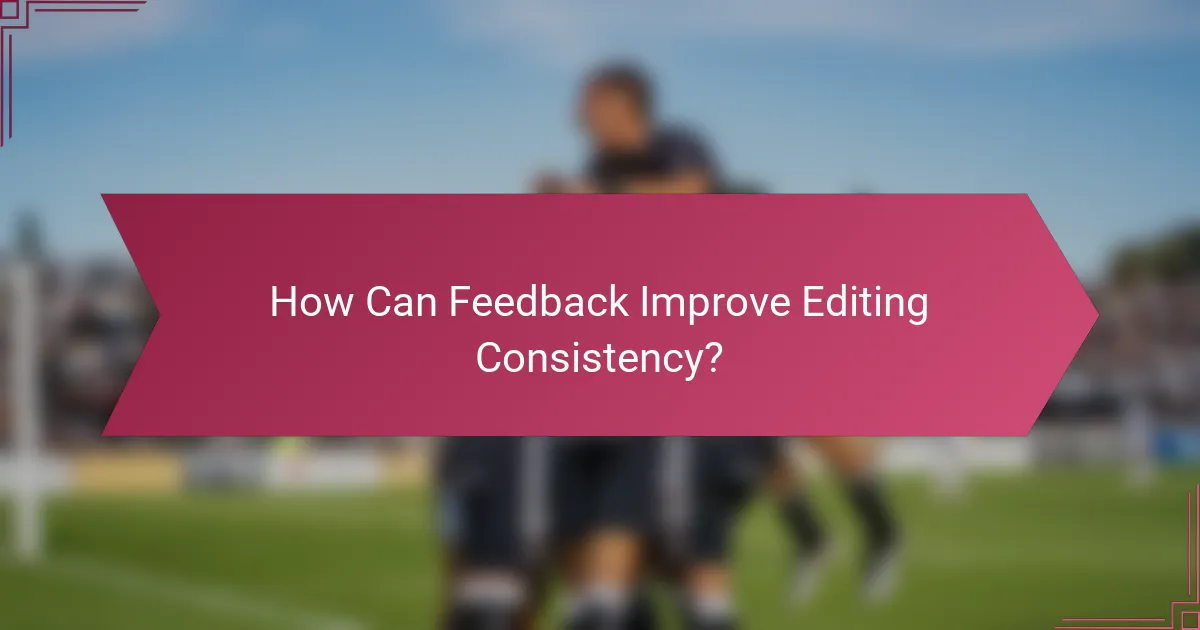
How Can Feedback Improve Editing Consistency?
Feedback is essential for enhancing editing consistency in wedding albums. By gathering insights from clients and peers, editors can identify areas for improvement and ensure a uniform style throughout the album.
Gathering Constructive Feedback
To improve editing consistency, actively seek constructive feedback from clients and colleagues. This can be done through surveys, direct conversations, or critique sessions. Aim for specific comments on aspects like color grading, cropping, and overall flow.
Consider using tools like Google Forms or Typeform to create structured feedback forms. This allows you to collect and analyze responses efficiently, ensuring you address common concerns and preferences.
Implementing Feedback into Your Workflow
Incorporate feedback into your editing process by establishing a clear workflow. Start by reviewing the feedback and identifying recurring themes. Prioritize changes that align with your editing style while addressing client preferences.
Utilize editing software features, such as presets or batch processing, to apply consistent adjustments across multiple images. This not only saves time but also helps maintain a cohesive look throughout the album.
Regular Review and Adjustment
Regularly review your editing style and the feedback received to ensure ongoing consistency. Set aside time every few months to assess your work against client expectations and industry standards. This practice helps you stay aligned with evolving trends and preferences.
Consider creating a style guide that outlines your editing choices, including color palettes and cropping techniques. This guide can serve as a reference for future projects, helping you maintain a consistent approach over time.
